 Previous Page Next Page
Previous Page Next Page
The wizard helps you to create a page report tab with a banded object in it or modify an existing banded object. It varies with the data resource type used for the banded object: business view or query resource.
Back
Goes back to the previous screen.
Next
Goes to the next screen.
Finish
Finishes creating or modifying the banded object and closes this wizard.
Cancel
Does not retain changes and closes this wizard.
Help
Displays the help document about this feature.
When the wizard is used for creating or editing a banded object using a business view, it consists of the following screens: Data, Display, Group, Summary, Filter and Style. Some screens are available only when the wizard is used for creating a banded object.
The screen lists all the predefined business views in the current catalog. Select the one you want to use for the banded object.
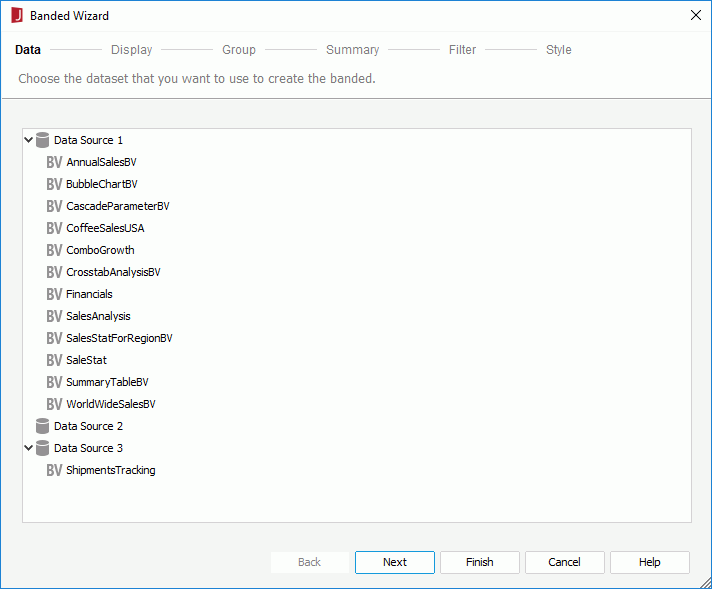
Specifies the detail fields to display in the banded object.
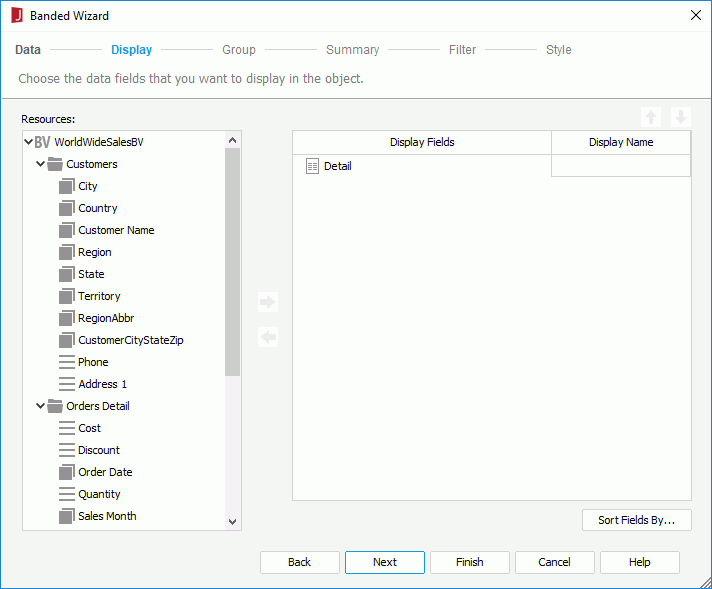
Resources
Lists the resources in and related to the specified business view, which can be used as detail fields in the banded object.

Adds the selected field in the Resources box to the banded object.

Removes the selected field from the banded object.

Replaces the selected field in the banded object with the specified field in the Resources box. Available only when modifying a banded object.

Moves the selected field one step up.

Moves the selected field one step down.
Show Banded Group Structure
Specifies whether to show the group structure of the banded object. Available only when modifying a banded object.
Display Fields
Lists the detail fields of the banded object.
Display Name
Specifies the labels of the detail columns in the banded object, which by default are the display names of the added fields. You can click in the text boxes to edit the labels, or check the Auto Map Field Name checkboxes in the text boxes to automatically map the label text to the dynamic display names of the fields at runtime.
Sort Fields By
Opens the Sort Fields By dialog to specify how to sort the detail data in the banded object.
Specifies the criteria for grouping data in the banded object.
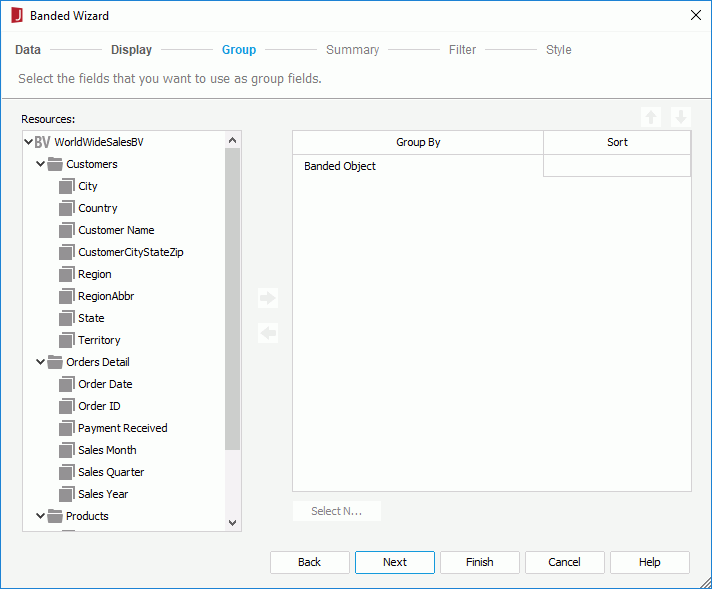
Resources
Lists the resources in and related to the specified business view, which can be used as group-by fields in the banded object.

Adds the selected field in the Resources box as a group-by field in the banded object.

Removes the selected group-by field from the banded object.

Replaces the selected group-by field in the banded object with the specified field in the Resources box. Available only when modifying a banded object.

Moves the selected group one step up.

Moves the selected group one step down.
Group By
Lists the group-by fields of the banded object.
Sort
Specifies how groups at the specific group level will be sorted.
Select N
Opens the Select N dialog to specify the Select N condition.
Specifies the summaries to calculate data in the banded object. This screen is available only when you create a banded object.
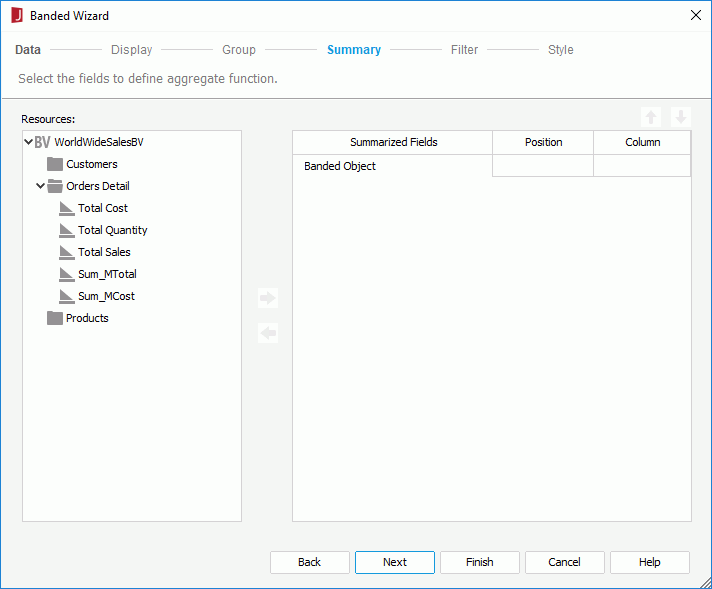
Resources
Lists the resources in and related to the specified business view, which can be used to calculate data in the banded object.

Adds the selected field in the Resources box to calculate data in the banded object.

Removes the selected summary from the banded object.

Moves the selected summary one step up.

Moves the selected summary one step down.
Summarized Fields
Lists the fields added to calculate data in the banded object.
Position
Displays the position of the summaries. A summary added for a group level is placed in the group's footer panel; if added for the Banded Object level, it will be placed in the banded footer panel.
Column
Displays in which column to place the summaries. By default the summaries and their name labels will be placed in the first two detail columns.
Specifies to filter data displayed in the banded object. This screen is available only when you create a banded object, and it contains the same options as those in the Edit Filter dialog.
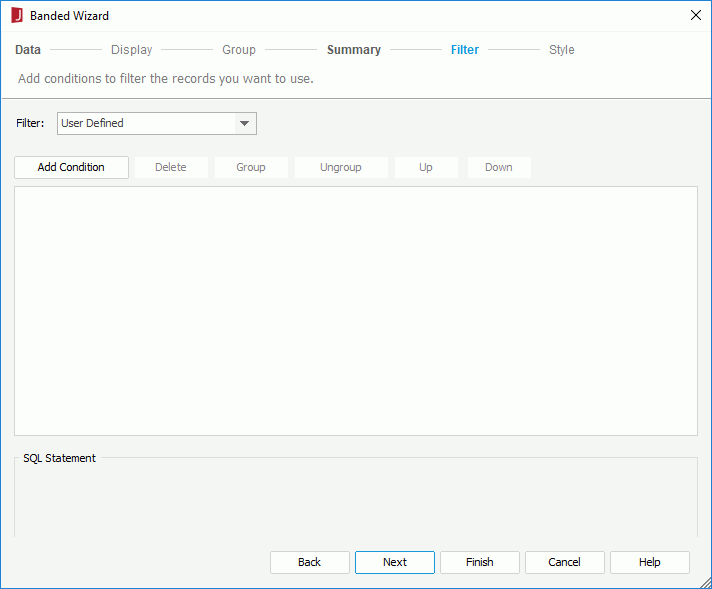
Specifies the style of the banded object.
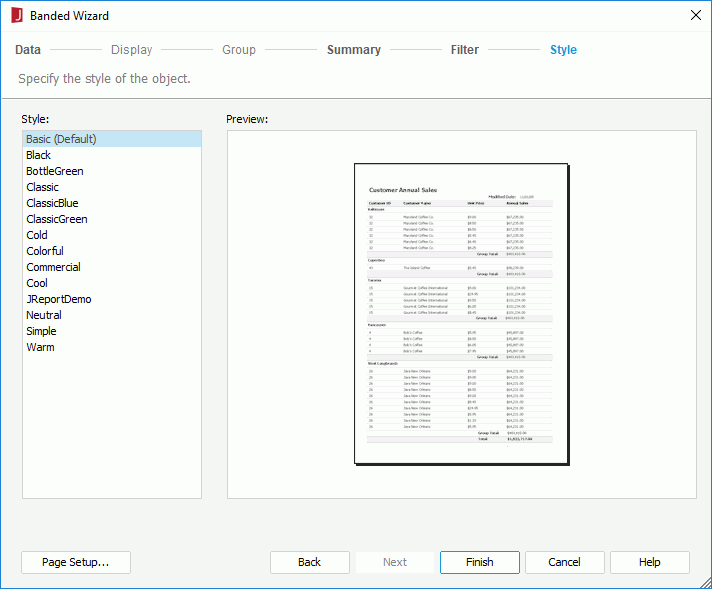
Style
Specifies the style of the banded object.
Preview
Displays a diagram illustrating the effect of the selected style on the banded object.
Inherit Style
Specifies whether to make the banded object take the style of its parent. This option is available only when you modify a banded object which is inserted into another banded object in a page report.
Page Setup
Opens the Page Setup dialog to specify page properties. Available only when creating a banded object.
When the wizard is used for creating or editing a banded object using a query resource, it consists of the following screens: Data, Display, Group, Summary, Chart, Filter and Style. Some screens are available only when the wizard is used for creating a banded object.
Specifies the dataset of the banded object.
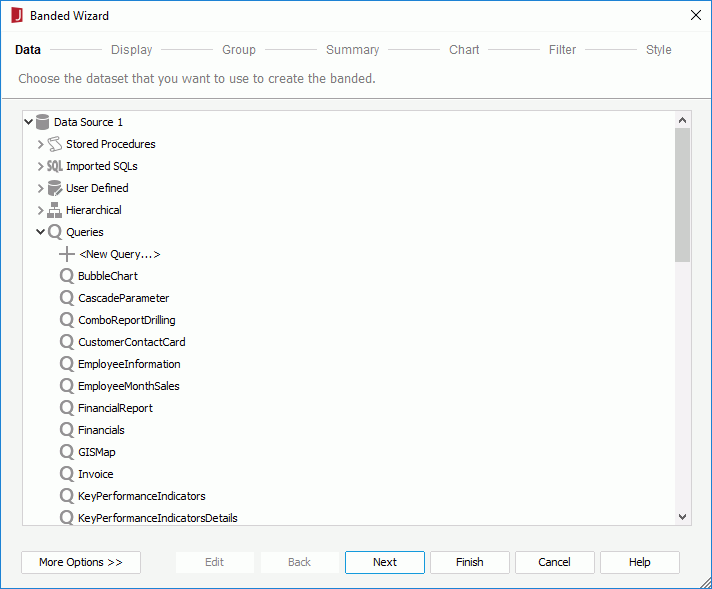
Data resource box
Lists the predefined data resources in the current catalog. Select one and a dataset based on it is created automatically for the banded object.
More Options/Less Options
Shows or hides the dataset selection panel to choose a dataset for the banded object.
Specifies the detail fields to display in the banded object.
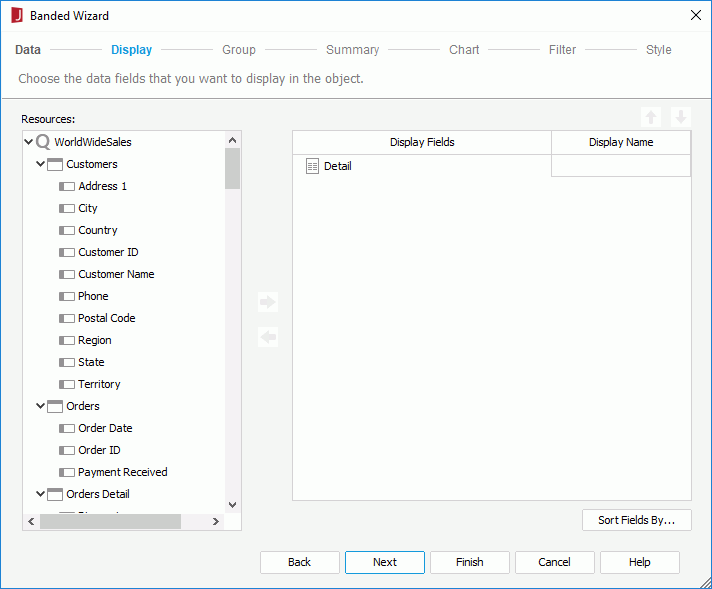
Resources
Lists the data fields in and related to the specified query resource, which can be used as detail fields in the banded object.

Adds the selected field in the Resources box to the banded object.

Removes the selected field from the banded object.

Replaces the selected field in the banded object with the specified field in the Resources box. Available only when modifying a banded object.

Moves the selected field one step up.

Moves the selected field one step down.
Show Banded Group Structure
Specifies whether to show the group structure of the banded object. Available only when modifying a banded object.
Display Fields
Lists the detail fields of the banded object.
Display Name
Specifies the labels of the detail columns in the banded object, which by default are the display names of the added fields. You can click in the text boxes to edit the labels if required.
Sort Fields By
Opens the Sort Fields By dialog to specify how to sort the detail data in the banded object.
Specifies the criteria for grouping data in the banded object.
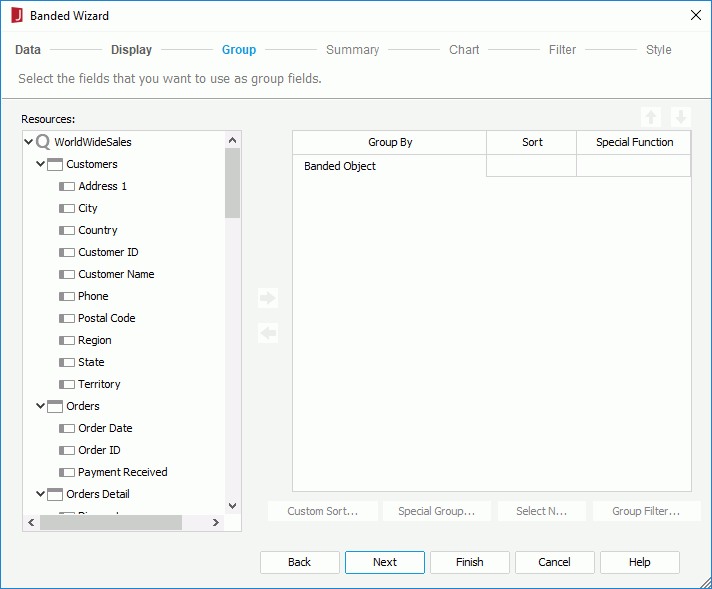
Resources
Lists the data fields in and related to the specified query resource, which can be used as group-by fields in the banded object.

Adds the selected field in the Resources box as a group-by field in the banded object.

Removes the selected group-by field from the banded object.

Replaces the selected group-by field in the banded object with the specified field in the Resources box. Available only when modifying a banded object.

Moves the selected group one step up.

Moves the selected group one step down.
Group By
Lists the group-by fields of the banded object.
Sort
Specifies how groups at the specific group level will be sorted.
Special Function
For a group-by field of the Numeric/String/Date/Time type, you can select a special function for it to specify to which level data will be grouped by. Select Customize to set the function in the Customized Function dialog.
Custom Sort
Specifies how to sort the groups. Activated only when you have selected Custom Sort from the Sort column to define the sort manner of groups for the selected group level.
Special Group
Specifies how to group your information. Activated only when you have clicked Special Group from the Sort column to define a special group.
Select N
Opens the Select N dialog to specify the Select N condition.
Group Filter
Opens the Group Filter dialog to specify the group filter condition.
Specifies the fields on which to create summaries in the banded object. This screen is available only when you create a banded object.
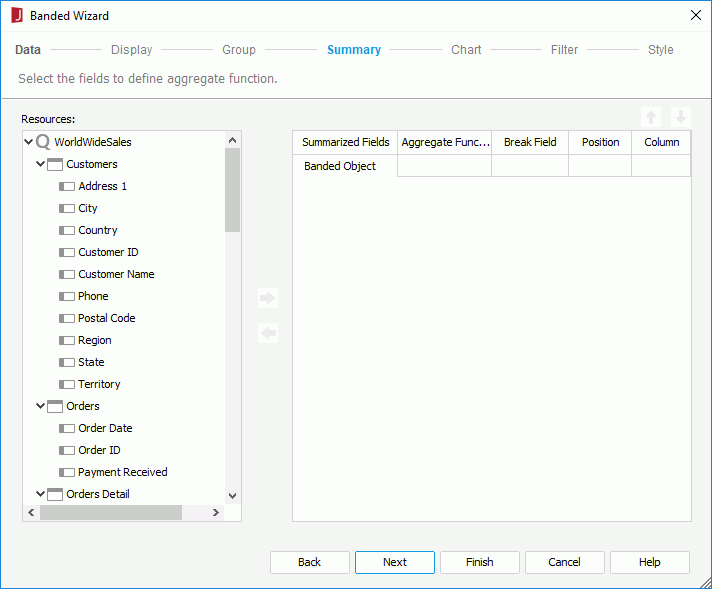
Resources
Lists the data fields in and related to the specified query resource, which can be used to create summaries in the banded object.

Adds the selected field in the Resources box based on which to create a summary in the banded object.

Removes the selected summary from the banded object.

Moves the selected summary one step up.

Moves the selected summary one step down.
Summarized Fields
Lists the fields that have been added to create summaries in the banded object.
Aggregate Function
Specifies the aggregate functions used for the summaries.
Break Field
Displays the groups on which the summaries will be calculated. If a summary is added for the Banded Object level, the break field is null and the summary will be calculated on the whole dataset.
Position
Works together with the Column option to specify the location where a summary will be placed.
Column
Works together with the Position option to specify the location where a summary will be placed.
Specifies to create a chart together with the banded object, which will be placed in the banded header panel. This screen is available only when you create a banded object, and when there is at least one group and one summary added for this group in the banded object.
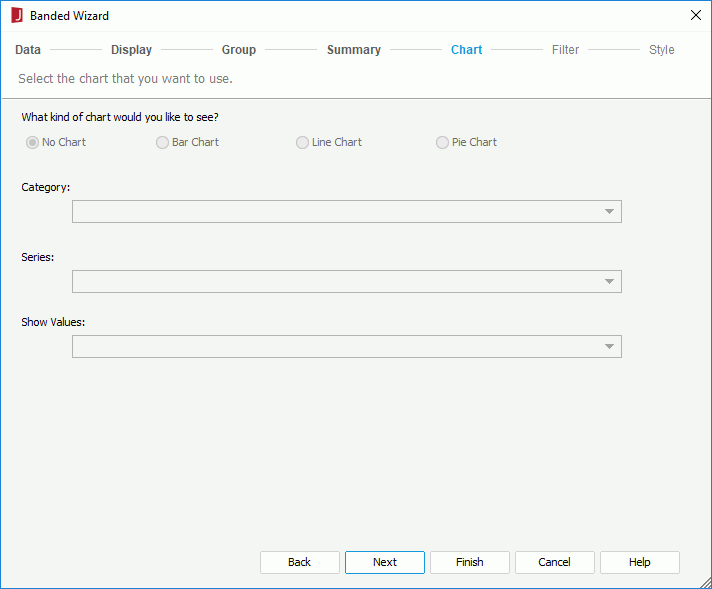
No Chart
Specifies not to create a chart.
Bar Chart
Specifies to create a Clustered Bar 2-D chart together with the banded object.
Line Chart
Specifies to create a Line 2-D chart together with the banded object.
Pie Chart
Specifies to create a Clustered Pie chart together with the banded object.
Category
Lists the group-by fields of the banded object on which summaries are added. Choose the field you want to display on the category (X) axis of the chart from the drop-down list.
Series
Lists the fields that have been added as the group-by fields of the banded object. Choose the field you want to display on the series (Z) axis of the chart from the drop-down list.
Show Values
Lists the summaries which are calculated based on the field you choose to display on the category axis of the chart. Choose the value you want to display in the chart from the drop-down list.
Specifies to filter data displayed in the banded object. This screen is available only when you create a banded object, and it contains the same options as those in the Edit Filter dialog.
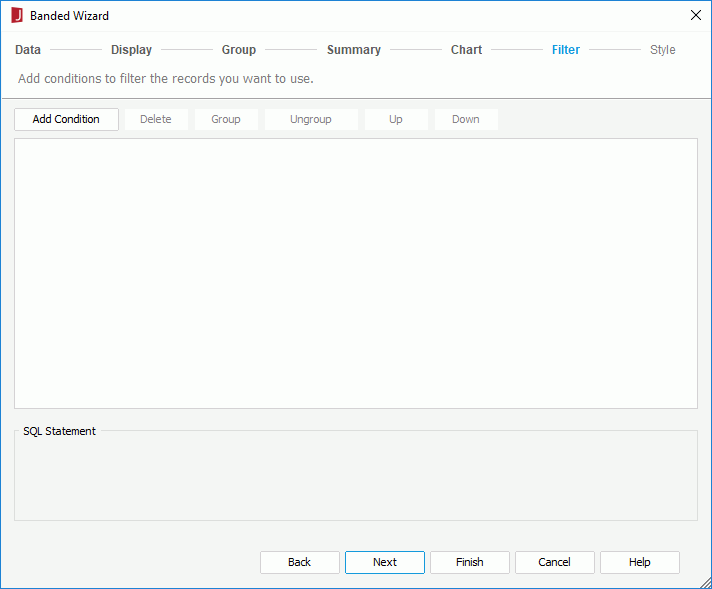
Specifies the style of the banded object.
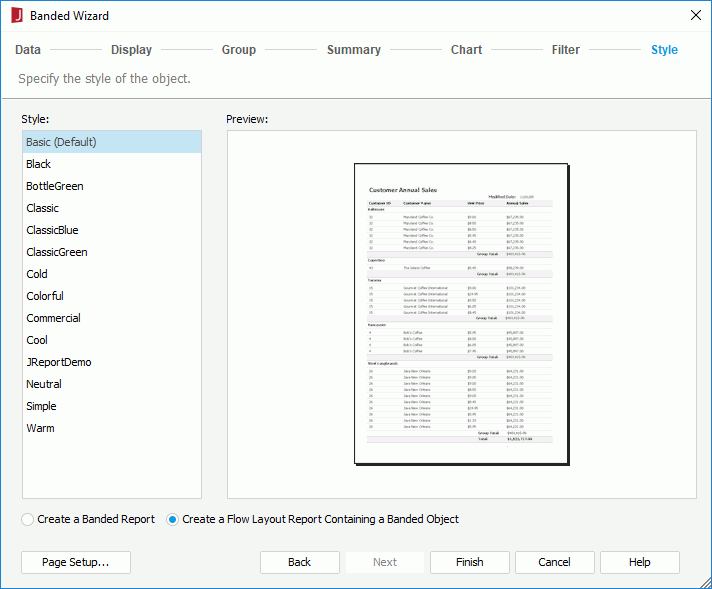
Style
Specifies the style of the banded object.
Preview
Displays a diagram illustrating the effect of the selected style on the banded object.
Inherit Style
Specifies whether to make the banded object take the style of its parent. Available only when you modify a banded object and the banded object is inserted into another banded object.
Create a Banded Report
Creates a restricted version of a flow layout report, one that can contain a single banded object only. This layout option is intended to provide compatibility with JReport Version 7 report templates. Available only when creating a banded object.
Create a Flow Layout Report Containing a Banded Object
Creates a report that contains a banded object mapped to the specified dataset. Available only when creating a banded object.
Page Setup
Opens the Page Setup dialog to specify page properties. Available only when creating a banded object.